Changing permafrost in a warming world and feedbacks to the Earth system
1
2016
... 在全球气候变暖的背景下,多年冻土已开始融化并将快速退化[1-3].据实测资料,北半球整体多年冻土活动层厚度增加[4].模拟结果也表明自1850年以来呈加深趋势,其中青藏高原地区最为显著[5].青藏高原近40年的增温速率比全球同期增温速率高约2倍[6],自1960—2008年的近50年温度增加了1.8 ℃,多年冻土退化显著[7-8],活动层厚度以 4.26 cm·a-1的速率增加[9].有研究表明,青藏高原腹地活动层厚度的增加速率为3.6~7.5 cm·a-1[8,10].青藏公路沿线的活动层温度以0.486 ℃·(10a)-1速率升温,活动层厚度以19.5 cm·(10a)-1的速率增加[6].1996年以来,沿线6.0 m深度处的多年冻土温度增加了0.08~0.55 ℃[8,11]. ...
Reviews and syntheses: Changing ecosystem influences on soil thermal regimes in northern high-latitude permafrost regions
0
2018
An observation-based constraint on permafrost loss as a function of global warming
1
2017
... 在全球气候变暖的背景下,多年冻土已开始融化并将快速退化[1-3].据实测资料,北半球整体多年冻土活动层厚度增加[4].模拟结果也表明自1850年以来呈加深趋势,其中青藏高原地区最为显著[5].青藏高原近40年的增温速率比全球同期增温速率高约2倍[6],自1960—2008年的近50年温度增加了1.8 ℃,多年冻土退化显著[7-8],活动层厚度以 4.26 cm·a-1的速率增加[9].有研究表明,青藏高原腹地活动层厚度的增加速率为3.6~7.5 cm·a-1[8,10].青藏公路沿线的活动层温度以0.486 ℃·(10a)-1速率升温,活动层厚度以19.5 cm·(10a)-1的速率增加[6].1996年以来,沿线6.0 m深度处的多年冻土温度增加了0.08~0.55 ℃[8,11]. ...
San Francisco: AGU
1
2016
... 在全球气候变暖的背景下,多年冻土已开始融化并将快速退化[1-3].据实测资料,北半球整体多年冻土活动层厚度增加[4].模拟结果也表明自1850年以来呈加深趋势,其中青藏高原地区最为显著[5].青藏高原近40年的增温速率比全球同期增温速率高约2倍[6],自1960—2008年的近50年温度增加了1.8 ℃,多年冻土退化显著[7-8],活动层厚度以 4.26 cm·a-1的速率增加[9].有研究表明,青藏高原腹地活动层厚度的增加速率为3.6~7.5 cm·a-1[8,10].青藏公路沿线的活动层温度以0.486 ℃·(10a)-1速率升温,活动层厚度以19.5 cm·(10a)-1的速率增加[6].1996年以来,沿线6.0 m深度处的多年冻土温度增加了0.08~0.55 ℃[8,11]. ...
Spatiotemporal changes in active layer thickness under contemporary and projected climate in the Northern Hemisphere
1
2018
... 在全球气候变暖的背景下,多年冻土已开始融化并将快速退化[1-3].据实测资料,北半球整体多年冻土活动层厚度增加[4].模拟结果也表明自1850年以来呈加深趋势,其中青藏高原地区最为显著[5].青藏高原近40年的增温速率比全球同期增温速率高约2倍[6],自1960—2008年的近50年温度增加了1.8 ℃,多年冻土退化显著[7-8],活动层厚度以 4.26 cm·a-1的速率增加[9].有研究表明,青藏高原腹地活动层厚度的增加速率为3.6~7.5 cm·a-1[8,10].青藏公路沿线的活动层温度以0.486 ℃·(10a)-1速率升温,活动层厚度以19.5 cm·(10a)-1的速率增加[6].1996年以来,沿线6.0 m深度处的多年冻土温度增加了0.08~0.55 ℃[8,11]. ...
青藏高原多年冻土特征、变化及影响
2
2019
... 在全球气候变暖的背景下,多年冻土已开始融化并将快速退化[1-3].据实测资料,北半球整体多年冻土活动层厚度增加[4].模拟结果也表明自1850年以来呈加深趋势,其中青藏高原地区最为显著[5].青藏高原近40年的增温速率比全球同期增温速率高约2倍[6],自1960—2008年的近50年温度增加了1.8 ℃,多年冻土退化显著[7-8],活动层厚度以 4.26 cm·a-1的速率增加[9].有研究表明,青藏高原腹地活动层厚度的增加速率为3.6~7.5 cm·a-1[8,10].青藏公路沿线的活动层温度以0.486 ℃·(10a)-1速率升温,活动层厚度以19.5 cm·(10a)-1的速率增加[6].1996年以来,沿线6.0 m深度处的多年冻土温度增加了0.08~0.55 ℃[8,11]. ...
... [6].1996年以来,沿线6.0 m深度处的多年冻土温度增加了0.08~0.55 ℃[8,11]. ...
青藏高原多年冻土特征、变化及影响
2
2019
... 在全球气候变暖的背景下,多年冻土已开始融化并将快速退化[1-3].据实测资料,北半球整体多年冻土活动层厚度增加[4].模拟结果也表明自1850年以来呈加深趋势,其中青藏高原地区最为显著[5].青藏高原近40年的增温速率比全球同期增温速率高约2倍[6],自1960—2008年的近50年温度增加了1.8 ℃,多年冻土退化显著[7-8],活动层厚度以 4.26 cm·a-1的速率增加[9].有研究表明,青藏高原腹地活动层厚度的增加速率为3.6~7.5 cm·a-1[8,10].青藏公路沿线的活动层温度以0.486 ℃·(10a)-1速率升温,活动层厚度以19.5 cm·(10a)-1的速率增加[6].1996年以来,沿线6.0 m深度处的多年冻土温度增加了0.08~0.55 ℃[8,11]. ...
... [6].1996年以来,沿线6.0 m深度处的多年冻土温度增加了0.08~0.55 ℃[8,11]. ...
Soil organic carbon pool of grassland soils on the Qinghai-Tibetan Plateau and its global implication
1
2002
... 在全球气候变暖的背景下,多年冻土已开始融化并将快速退化[1-3].据实测资料,北半球整体多年冻土活动层厚度增加[4].模拟结果也表明自1850年以来呈加深趋势,其中青藏高原地区最为显著[5].青藏高原近40年的增温速率比全球同期增温速率高约2倍[6],自1960—2008年的近50年温度增加了1.8 ℃,多年冻土退化显著[7-8],活动层厚度以 4.26 cm·a-1的速率增加[9].有研究表明,青藏高原腹地活动层厚度的增加速率为3.6~7.5 cm·a-1[8,10].青藏公路沿线的活动层温度以0.486 ℃·(10a)-1速率升温,活动层厚度以19.5 cm·(10a)-1的速率增加[6].1996年以来,沿线6.0 m深度处的多年冻土温度增加了0.08~0.55 ℃[8,11]. ...
Temporal and spatial variations of the active layer along the Qinghai-Tibet Highway in a permafrost region
3
2012
... 在全球气候变暖的背景下,多年冻土已开始融化并将快速退化[1-3].据实测资料,北半球整体多年冻土活动层厚度增加[4].模拟结果也表明自1850年以来呈加深趋势,其中青藏高原地区最为显著[5].青藏高原近40年的增温速率比全球同期增温速率高约2倍[6],自1960—2008年的近50年温度增加了1.8 ℃,多年冻土退化显著[7-8],活动层厚度以 4.26 cm·a-1的速率增加[9].有研究表明,青藏高原腹地活动层厚度的增加速率为3.6~7.5 cm·a-1[8,10].青藏公路沿线的活动层温度以0.486 ℃·(10a)-1速率升温,活动层厚度以19.5 cm·(10a)-1的速率增加[6].1996年以来,沿线6.0 m深度处的多年冻土温度增加了0.08~0.55 ℃[8,11]. ...
... -1[8,10].青藏公路沿线的活动层温度以0.486 ℃·(10a)-1速率升温,活动层厚度以19.5 cm·(10a)-1的速率增加[6].1996年以来,沿线6.0 m深度处的多年冻土温度增加了0.08~0.55 ℃[8,11]. ...
... [8,11]. ...
Changes in active-layer thickness and near-surface permafrost between 2002 and 2012 in alpine ecosystems, Qinghai-Xizang (Tibet) Plateau, China
3
2015
... 在全球气候变暖的背景下,多年冻土已开始融化并将快速退化[1-3].据实测资料,北半球整体多年冻土活动层厚度增加[4].模拟结果也表明自1850年以来呈加深趋势,其中青藏高原地区最为显著[5].青藏高原近40年的增温速率比全球同期增温速率高约2倍[6],自1960—2008年的近50年温度增加了1.8 ℃,多年冻土退化显著[7-8],活动层厚度以 4.26 cm·a-1的速率增加[9].有研究表明,青藏高原腹地活动层厚度的增加速率为3.6~7.5 cm·a-1[8,10].青藏公路沿线的活动层温度以0.486 ℃·(10a)-1速率升温,活动层厚度以19.5 cm·(10a)-1的速率增加[6].1996年以来,沿线6.0 m深度处的多年冻土温度增加了0.08~0.55 ℃[8,11]. ...
... 2013—2018年,EB和PT1两个监测场的活动层厚度没有明显变化趋势[23],平均活动层厚度分别为74.2 cm和162.1 cm.EB和PT1监测场的活动层厚度变化范围为分别为61~86 cm和159~164 cm.根据表4,EB和PT1监测场的活动层最大和最小的年份不一致.PT1监测场,2014年的活动层厚度最大,2015年的活动层厚度最小.EB监测场,2015年的活动层厚度最大,2017年的活动层厚度最小,相隔两年的活动层厚度变化达25 cm.相较于青藏高原北麓河地区活动层厚度以4.26 cm·a-1的速率增加[9],青藏高原平均活动层厚度呈增加趋势[51],祁连山黑河流域PT1和EB监测场,2013—2018年的活动层厚度没有明显的变化趋势. ...
... 在PT1监测场,2014年的活动层厚度最大.2014年的土壤融化开始时间较其他年份平均约提前12天,土壤冻结开始时间较平均推迟了6天.2013年的土壤融化期开始时间虽然提前约24天,土壤融化期比2014年长5天,但在积雪的隔热保温作用下,2013年融化期的平均土壤温度较2014年的约低0.23 ℃.2018年融化期的平均温度高于其他年份约1 ℃,但融化期时间长度比其他年份缩短20~25 天.在EB监测场,2015年的活动层厚度最大,土壤冻结开始时间相较平均冻结开始时间推迟了12天.2014年9月末—2015年3月末的厚度较厚且逐渐增加的积雪对土壤的保温作用,使得2015年开始至4月10日的平均土壤温度较其他年份相同时间段高约2.61 ℃.2017年的活动层厚度最小,这主要由于2017年的土壤融化期开始时间最迟,且融化期内活动层的平均温度低于其他年份(表5,图9).由此可见,积雪对活动层厚度的影响主要体现在土壤冻结和融化开始时间以及土壤温度两个方面.若未来积雪厚度增加,则有可能导致土壤升温,活动层厚度加深[9]. ...
Changes in active layer thickness over the Qinghai-Tibetan Plateau from 1995 to 2007
1
2010
... 在全球气候变暖的背景下,多年冻土已开始融化并将快速退化[1-3].据实测资料,北半球整体多年冻土活动层厚度增加[4].模拟结果也表明自1850年以来呈加深趋势,其中青藏高原地区最为显著[5].青藏高原近40年的增温速率比全球同期增温速率高约2倍[6],自1960—2008年的近50年温度增加了1.8 ℃,多年冻土退化显著[7-8],活动层厚度以 4.26 cm·a-1的速率增加[9].有研究表明,青藏高原腹地活动层厚度的增加速率为3.6~7.5 cm·a-1[8,10].青藏公路沿线的活动层温度以0.486 ℃·(10a)-1速率升温,活动层厚度以19.5 cm·(10a)-1的速率增加[6].1996年以来,沿线6.0 m深度处的多年冻土温度增加了0.08~0.55 ℃[8,11]. ...
Permafrost warming in the context of step-wise climate change in the Tien Shan mountains, China
1
2017
... 在全球气候变暖的背景下,多年冻土已开始融化并将快速退化[1-3].据实测资料,北半球整体多年冻土活动层厚度增加[4].模拟结果也表明自1850年以来呈加深趋势,其中青藏高原地区最为显著[5].青藏高原近40年的增温速率比全球同期增温速率高约2倍[6],自1960—2008年的近50年温度增加了1.8 ℃,多年冻土退化显著[7-8],活动层厚度以 4.26 cm·a-1的速率增加[9].有研究表明,青藏高原腹地活动层厚度的增加速率为3.6~7.5 cm·a-1[8,10].青藏公路沿线的活动层温度以0.486 ℃·(10a)-1速率升温,活动层厚度以19.5 cm·(10a)-1的速率增加[6].1996年以来,沿线6.0 m深度处的多年冻土温度增加了0.08~0.55 ℃[8,11]. ...
1
2015
... 积雪对中高纬度地带和高海拔地区的生态系统变化具有显著影响[12-14].积雪通过影响表面能量平衡改变天气和气候[15],影响土壤热状态[14,16-18]以及陆地和大气的碳交换等.一方面,积雪的高反照率有利于地表的降温和下伏土层的冷却[14];另一方面,积雪因其低导热率特性而具有良好的隔热作用,可以减少冬季陆地热量的损失.积雪的起止时间、持续时间、积雪厚度、密度、结构等,都会对积雪的隔热效应产生影响[19].但由于植被等局地因素以及积雪密度、湿度等因素的不同,不同地区积雪保温效应的雪深阈值差异较大[14,20].在青藏高原地区,观测资料表明,厚度低于20 cm的积雪对土壤热状态基本无影响,而CoupModel的模拟结果则显示其降低了土壤温度并会增加土壤冻结深度[21].在青藏高原不同地区,积雪的影响也不同[22]. ...
Influence of snow cover and grain size on the ground thermal regime in the discontinuous permafrost zone, Swiss Alps
0
2012
Influence of the seasonal snow cover on the ground thermal regime: An overview
10
2005
... 积雪对中高纬度地带和高海拔地区的生态系统变化具有显著影响[12-14].积雪通过影响表面能量平衡改变天气和气候[15],影响土壤热状态[14,16-18]以及陆地和大气的碳交换等.一方面,积雪的高反照率有利于地表的降温和下伏土层的冷却[14];另一方面,积雪因其低导热率特性而具有良好的隔热作用,可以减少冬季陆地热量的损失.积雪的起止时间、持续时间、积雪厚度、密度、结构等,都会对积雪的隔热效应产生影响[19].但由于植被等局地因素以及积雪密度、湿度等因素的不同,不同地区积雪保温效应的雪深阈值差异较大[14,20].在青藏高原地区,观测资料表明,厚度低于20 cm的积雪对土壤热状态基本无影响,而CoupModel的模拟结果则显示其降低了土壤温度并会增加土壤冻结深度[21].在青藏高原不同地区,积雪的影响也不同[22]. ...
... [14,16-18]以及陆地和大气的碳交换等.一方面,积雪的高反照率有利于地表的降温和下伏土层的冷却[14];另一方面,积雪因其低导热率特性而具有良好的隔热作用,可以减少冬季陆地热量的损失.积雪的起止时间、持续时间、积雪厚度、密度、结构等,都会对积雪的隔热效应产生影响[19].但由于植被等局地因素以及积雪密度、湿度等因素的不同,不同地区积雪保温效应的雪深阈值差异较大[14,20].在青藏高原地区,观测资料表明,厚度低于20 cm的积雪对土壤热状态基本无影响,而CoupModel的模拟结果则显示其降低了土壤温度并会增加土壤冻结深度[21].在青藏高原不同地区,积雪的影响也不同[22]. ...
... [14];另一方面,积雪因其低导热率特性而具有良好的隔热作用,可以减少冬季陆地热量的损失.积雪的起止时间、持续时间、积雪厚度、密度、结构等,都会对积雪的隔热效应产生影响[19].但由于植被等局地因素以及积雪密度、湿度等因素的不同,不同地区积雪保温效应的雪深阈值差异较大[14,20].在青藏高原地区,观测资料表明,厚度低于20 cm的积雪对土壤热状态基本无影响,而CoupModel的模拟结果则显示其降低了土壤温度并会增加土壤冻结深度[21].在青藏高原不同地区,积雪的影响也不同[22]. ...
... [14,20].在青藏高原地区,观测资料表明,厚度低于20 cm的积雪对土壤热状态基本无影响,而CoupModel的模拟结果则显示其降低了土壤温度并会增加土壤冻结深度[21].在青藏高原不同地区,积雪的影响也不同[22]. ...
... 冻融指数(freezing-thawing index,FTI)是重要的气候变化指示参数,对冻土研究具有重要意义[42].积雪指数(snow cover height index,SCHI)是衡量冬季积雪持续时间和厚度的综合指标[43].冻融指数是气温或者地温在一定时间段内的温度累加值.年冻结(融化)指数是指一年内负温(正温)的日平均温度的累计[44-46].冻结指数和积雪指数的计算时间为每年7月1日到翌年6月30日,融化指数计算时间为每年1月1日至12月31日[14,43,47].本文使用日平均气温和地表温度(5 cm土壤温度)计算空气和地表冻融指数.冻融指数的表达式为: ...
... EB和PT1监测场的积雪观测时间不同,分别为2014年9月26日—2016年6月23日及2014年10月5日—2019年4月10日.降雪主要集中在春季的4—5月及秋季10—11月.2014年秋季持续至2015年春的降雪事件,为EB和PT1监测场有观测年份的最大积雪厚度,分别为38 cm和33 cm(图3).根据观测数据,祁连山地区一场新雪维持的天数最多为9天[图4(a)],表明本地区积雪易受气温等的影响而消融[33].尽管积雪消融速度较快,积雪对地表反照率和表面净辐射具有显著影响[图4(c)].受山地地形的影响,新雪的反照率最大可以达到0.98;积雪的融化、密实化以及污化物的增多,陈雪的表面反照率较低,两站点的平均反照率为0.28[图4(c)].雪表的高反照率和较强的反射辐射,降低了表面辐射平衡值,加剧了地表热量损失[14].因为积雪对太阳辐射的吸收和反射,积雪粒径越大,太阳辐射穿透的越深[48].积雪厚度与净辐射呈幂函数关系,随着积雪厚度增加,净辐射逐渐减小,变化速率也逐渐减小[图4(b)],说明积雪对辐射的影响并不只是积雪表面.且有研究表明,青藏高原的积雪反馈强度达到9.35 W·m-2·℃-1[49].因此,在能量平衡模型中仅仅考虑积雪表面反照率对表面能量平衡的影响是不够的[50]. ...
... 根据以上分析,祁连山区黑河上游积雪隔热保温效应深度阈值约为21 cm,不同于新疆天山地区冬季的10 cm[20],这与不同研究区域的积雪密度、结构等特征以及积雪的起止时间、持续时间[14]有关. ...
... 积雪是影响活动层厚度的一个重要因素[14,52],当积雪厚度相对较小或无积雪存在时,活动层厚度主要与气温有关[53],积雪厚度较大时,积雪对活动层厚度的影响甚至会超过气温[54].在PT1监测场,2014年的FIa较高,TIa较低.2014年比2013年的FIa高87 ℃·d,TIa低157 ℃·d,但在4 095 cm·d的最大观测积雪指数影响下,2014年的活动层厚度相比2013年增加1.5 cm,且2014年的活动层厚度最大.在EB监测场,2015年观测的积雪指数最大,为 4 730 cm·d,导致FIa和FIs相差达1 106 ℃·d,TIa最低,FIa值偏大.2015年的活动层厚度最大,较FIa最低和TIa最高的2014年的活动层厚度增加了9 cm.相较于2015年,2017年的TIa低133 ℃·d,FIa低51 ℃·d,活动层厚度却小25 cm(图8和表4).以上说明上一个冬季厚度较大且积累时间较长的积雪,对土壤具有显著的隔热保温作用,加深活动层厚度[14,53]. ...
... [14,53]. ...
... 积雪是影响活动层厚度的一个重要因素[14],具有一定厚度或持续时间较长的积雪,对地表具有隔热保温效应,减少地表热量损失.积雪对土壤的隔热效应影响土壤冻结和融化的开始时间及土壤温度,并进一步影响多年冻土活动层厚度的变化[55].根据本研究发现,若未来积雪厚度增加,则可能导致多年冻土退化,加速土壤有机碳分解释放[28,57],影响碳循环过程.但由于本研究中两个监测场的野外观测时间有限,无法对积雪对气候反馈的长期效应做更系统的分析.在今后的研究中应重视未来祁连山区黑河上游积雪厚度的变化趋势研究[32,35,58],加强积雪对多年冻土及其活动层热状态影响的研究,增加气象监测台站并进行持续观测. ...
Snow-shrub interactions in Arctic tundra: A hypothesis with climatic implications
1
2001
... 积雪对中高纬度地带和高海拔地区的生态系统变化具有显著影响[12-14].积雪通过影响表面能量平衡改变天气和气候[15],影响土壤热状态[14,16-18]以及陆地和大气的碳交换等.一方面,积雪的高反照率有利于地表的降温和下伏土层的冷却[14];另一方面,积雪因其低导热率特性而具有良好的隔热作用,可以减少冬季陆地热量的损失.积雪的起止时间、持续时间、积雪厚度、密度、结构等,都会对积雪的隔热效应产生影响[19].但由于植被等局地因素以及积雪密度、湿度等因素的不同,不同地区积雪保温效应的雪深阈值差异较大[14,20].在青藏高原地区,观测资料表明,厚度低于20 cm的积雪对土壤热状态基本无影响,而CoupModel的模拟结果则显示其降低了土壤温度并会增加土壤冻结深度[21].在青藏高原不同地区,积雪的影响也不同[22]. ...
Impact of the timing and duration of seasonal snow cover on the active layer and permafrost in the Alaskan Arctic
1
2003
... 积雪对中高纬度地带和高海拔地区的生态系统变化具有显著影响[12-14].积雪通过影响表面能量平衡改变天气和气候[15],影响土壤热状态[14,16-18]以及陆地和大气的碳交换等.一方面,积雪的高反照率有利于地表的降温和下伏土层的冷却[14];另一方面,积雪因其低导热率特性而具有良好的隔热作用,可以减少冬季陆地热量的损失.积雪的起止时间、持续时间、积雪厚度、密度、结构等,都会对积雪的隔热效应产生影响[19].但由于植被等局地因素以及积雪密度、湿度等因素的不同,不同地区积雪保温效应的雪深阈值差异较大[14,20].在青藏高原地区,观测资料表明,厚度低于20 cm的积雪对土壤热状态基本无影响,而CoupModel的模拟结果则显示其降低了土壤温度并会增加土壤冻结深度[21].在青藏高原不同地区,积雪的影响也不同[22]. ...
Sensitivity of active layer freezing process to snow cover in Arctic Alaska
1
2018
... 积雪影响土壤温度、土壤含水量以及土壤冻结和融化的开始时间,从而影响多年冻土活动层厚度[55].土壤融化开始时间提前和冻结开始时间延后均有可能使活动层厚度增加[17,56].在2014年秋季至2015年春季的积累时间较长且厚度较大的积雪影响下,2014年末至2015年初PT1和EB监测场的土壤温度明显高于其他年份同期.另外,PT1监测场在2017年冬末至春季的积雪影响下的土壤温度也明显较高(图3和图9). ...
从地表能量平衡各分量特点论青藏高原多年冻土工程中的冻土保护措施
1
2006
... 积雪对中高纬度地带和高海拔地区的生态系统变化具有显著影响[12-14].积雪通过影响表面能量平衡改变天气和气候[15],影响土壤热状态[14,16-18]以及陆地和大气的碳交换等.一方面,积雪的高反照率有利于地表的降温和下伏土层的冷却[14];另一方面,积雪因其低导热率特性而具有良好的隔热作用,可以减少冬季陆地热量的损失.积雪的起止时间、持续时间、积雪厚度、密度、结构等,都会对积雪的隔热效应产生影响[19].但由于植被等局地因素以及积雪密度、湿度等因素的不同,不同地区积雪保温效应的雪深阈值差异较大[14,20].在青藏高原地区,观测资料表明,厚度低于20 cm的积雪对土壤热状态基本无影响,而CoupModel的模拟结果则显示其降低了土壤温度并会增加土壤冻结深度[21].在青藏高原不同地区,积雪的影响也不同[22]. ...
从地表能量平衡各分量特点论青藏高原多年冻土工程中的冻土保护措施
1
2006
... 积雪对中高纬度地带和高海拔地区的生态系统变化具有显著影响[12-14].积雪通过影响表面能量平衡改变天气和气候[15],影响土壤热状态[14,16-18]以及陆地和大气的碳交换等.一方面,积雪的高反照率有利于地表的降温和下伏土层的冷却[14];另一方面,积雪因其低导热率特性而具有良好的隔热作用,可以减少冬季陆地热量的损失.积雪的起止时间、持续时间、积雪厚度、密度、结构等,都会对积雪的隔热效应产生影响[19].但由于植被等局地因素以及积雪密度、湿度等因素的不同,不同地区积雪保温效应的雪深阈值差异较大[14,20].在青藏高原地区,观测资料表明,厚度低于20 cm的积雪对土壤热状态基本无影响,而CoupModel的模拟结果则显示其降低了土壤温度并会增加土壤冻结深度[21].在青藏高原不同地区,积雪的影响也不同[22]. ...
Influence of the depth hoar layer of the seasonal snow cover on the ground thermal regime
1
1996
... 积雪对中高纬度地带和高海拔地区的生态系统变化具有显著影响[12-14].积雪通过影响表面能量平衡改变天气和气候[15],影响土壤热状态[14,16-18]以及陆地和大气的碳交换等.一方面,积雪的高反照率有利于地表的降温和下伏土层的冷却[14];另一方面,积雪因其低导热率特性而具有良好的隔热作用,可以减少冬季陆地热量的损失.积雪的起止时间、持续时间、积雪厚度、密度、结构等,都会对积雪的隔热效应产生影响[19].但由于植被等局地因素以及积雪密度、湿度等因素的不同,不同地区积雪保温效应的雪深阈值差异较大[14,20].在青藏高原地区,观测资料表明,厚度低于20 cm的积雪对土壤热状态基本无影响,而CoupModel的模拟结果则显示其降低了土壤温度并会增加土壤冻结深度[21].在青藏高原不同地区,积雪的影响也不同[22]. ...
Snow cover influences the thermal regime of active layer in Urumqi River Source, Tianshan Mountains, China
2
2018
... 积雪对中高纬度地带和高海拔地区的生态系统变化具有显著影响[12-14].积雪通过影响表面能量平衡改变天气和气候[15],影响土壤热状态[14,16-18]以及陆地和大气的碳交换等.一方面,积雪的高反照率有利于地表的降温和下伏土层的冷却[14];另一方面,积雪因其低导热率特性而具有良好的隔热作用,可以减少冬季陆地热量的损失.积雪的起止时间、持续时间、积雪厚度、密度、结构等,都会对积雪的隔热效应产生影响[19].但由于植被等局地因素以及积雪密度、湿度等因素的不同,不同地区积雪保温效应的雪深阈值差异较大[14,20].在青藏高原地区,观测资料表明,厚度低于20 cm的积雪对土壤热状态基本无影响,而CoupModel的模拟结果则显示其降低了土壤温度并会增加土壤冻结深度[21].在青藏高原不同地区,积雪的影响也不同[22]. ...
... 根据以上分析,祁连山区黑河上游积雪隔热保温效应深度阈值约为21 cm,不同于新疆天山地区冬季的10 cm[20],这与不同研究区域的积雪密度、结构等特征以及积雪的起止时间、持续时间[14]有关. ...
Monitoring and modeling the influence of snow pack and organic soil on a permafrost active layer, Qinghai-Tibetan Plateau of China
1
2013
... 积雪对中高纬度地带和高海拔地区的生态系统变化具有显著影响[12-14].积雪通过影响表面能量平衡改变天气和气候[15],影响土壤热状态[14,16-18]以及陆地和大气的碳交换等.一方面,积雪的高反照率有利于地表的降温和下伏土层的冷却[14];另一方面,积雪因其低导热率特性而具有良好的隔热作用,可以减少冬季陆地热量的损失.积雪的起止时间、持续时间、积雪厚度、密度、结构等,都会对积雪的隔热效应产生影响[19].但由于植被等局地因素以及积雪密度、湿度等因素的不同,不同地区积雪保温效应的雪深阈值差异较大[14,20].在青藏高原地区,观测资料表明,厚度低于20 cm的积雪对土壤热状态基本无影响,而CoupModel的模拟结果则显示其降低了土壤温度并会增加土壤冻结深度[21].在青藏高原不同地区,积雪的影响也不同[22]. ...
Dual influences of local environmental variables on ground temperatures on the Qinghai-Tibet Plateau
2
... 积雪对中高纬度地带和高海拔地区的生态系统变化具有显著影响[12-14].积雪通过影响表面能量平衡改变天气和气候[15],影响土壤热状态[14,16-18]以及陆地和大气的碳交换等.一方面,积雪的高反照率有利于地表的降温和下伏土层的冷却[14];另一方面,积雪因其低导热率特性而具有良好的隔热作用,可以减少冬季陆地热量的损失.积雪的起止时间、持续时间、积雪厚度、密度、结构等,都会对积雪的隔热效应产生影响[19].但由于植被等局地因素以及积雪密度、湿度等因素的不同,不同地区积雪保温效应的雪深阈值差异较大[14,20].在青藏高原地区,观测资料表明,厚度低于20 cm的积雪对土壤热状态基本无影响,而CoupModel的模拟结果则显示其降低了土壤温度并会增加土壤冻结深度[21].在青藏高原不同地区,积雪的影响也不同[22]. ...
... 青藏高原地区冬季地表长波辐射冷却大于其接收的太阳短波辐射,地表以热量损失为主;具有一定厚度或持续时间较长的积雪,则因其低导热率和陈雪的低表面反照率,以及地表长波辐射冷却的减少,使积雪对地表具有隔热保温效应,减少地表热量损失[22].2014年,PT1监测场的年平均气温为-5.16 ℃.10月至次年3月末的平均积雪厚度达21 cm,地表土壤温度比其他年份相同时间段高约2.05 ℃.如图6所示,随着积雪厚度从21 cm增加至30 cm,土壤热通量值逐渐从-7.02 W·m-2增加至0 W·m-2左右.由此表明,秋冬季21 cm及以上积雪厚度对土壤具有保温作用,防止土壤热量的进一步损失.但由于气温的持续降低,地表热量持续散失,因此一段时间后的土壤温度降低至0 ℃以下. ...
Thermal characteristics and recent changes of permafrost in the upper reaches of the Heihe River basin, Western China
6
2018
... 祁连山位于青藏高原东北部,属于高原亚寒带半干旱气候区.其降水主要集中在夏季,冬季降水极少[32].1956—2006年的年平均气温为-0.8 ℃,年平均降水量为403 mm,且均呈增加趋势[36].受高海拔影响,祁连山地区多年冻土和季节冻土发育.根据2012—2017年的有限钻孔观测结果,活动层厚度为约1 m [37]至5 m[23],同一钻孔的活动层厚度变化达到0.73 m[24].16~18 m深度的年平均地温变化范围为-1.71~2.34 ℃,且呈不同程度的升温[23].本研究选取祁连山区黑河上游俄博岭(EB,37.997° N,100.916° E,海拔3 691 m)和野牛沟热水达坂(PT1,98.745° N,38.782° E,海拔4 128 m)两个监测站进行气象和多年冻土热状态观测(图1)[23,38].根据多年冻土概率分布(permafrost zonation index,PZI)[38]及野外观测,两监测站点有以下几点共性:位于多年冻土区,坡向北偏东,植被类型为高寒沼泽草甸,土壤有机质含量与含冰量较高,表层土壤为泥炭层[23,27](图2).相较于PT1监测场,EB监测场位于阴坡,植被更加发育,泥炭层更厚[27]. ...
... [23].本研究选取祁连山区黑河上游俄博岭(EB,37.997° N,100.916° E,海拔3 691 m)和野牛沟热水达坂(PT1,98.745° N,38.782° E,海拔4 128 m)两个监测站进行气象和多年冻土热状态观测(图1)[23,38].根据多年冻土概率分布(permafrost zonation index,PZI)[38]及野外观测,两监测站点有以下几点共性:位于多年冻土区,坡向北偏东,植被类型为高寒沼泽草甸,土壤有机质含量与含冰量较高,表层土壤为泥炭层[23,27](图2).相较于PT1监测场,EB监测场位于阴坡,植被更加发育,泥炭层更厚[27]. ...
... [23,38].根据多年冻土概率分布(permafrost zonation index,PZI)[38]及野外观测,两监测站点有以下几点共性:位于多年冻土区,坡向北偏东,植被类型为高寒沼泽草甸,土壤有机质含量与含冰量较高,表层土壤为泥炭层[23,27](图2).相较于PT1监测场,EB监测场位于阴坡,植被更加发育,泥炭层更厚[27]. ...
... [23,27](图2).相较于PT1监测场,EB监测场位于阴坡,植被更加发育,泥炭层更厚[27]. ...
... 活动层厚度定义为0 ℃等温线的最大深度[39],本文使用观测的日平均土壤温度,从三个最深的年最高温度中插值得到[23,40].黑河上游最大活动层厚度一般出现在9—10月,该时间段数据缺测导致某些年份活动层厚度数据缺失.根据本研究中监测场的土壤温度特征,定义融化期开始时间为每年首次连续5天地表温度高于0 ℃的首日,冻结期开始时间为每年秋冬季节首次连续5天地表温度低于0 ℃的首日[41].融化期开始时间至冻结期开始时间段内为融化期,冻结期开始时间至融化期开始时间段内为冻结期. ...
... 2013—2018年,EB和PT1两个监测场的活动层厚度没有明显变化趋势[23],平均活动层厚度分别为74.2 cm和162.1 cm.EB和PT1监测场的活动层厚度变化范围为分别为61~86 cm和159~164 cm.根据表4,EB和PT1监测场的活动层最大和最小的年份不一致.PT1监测场,2014年的活动层厚度最大,2015年的活动层厚度最小.EB监测场,2015年的活动层厚度最大,2017年的活动层厚度最小,相隔两年的活动层厚度变化达25 cm.相较于青藏高原北麓河地区活动层厚度以4.26 cm·a-1的速率增加[9],青藏高原平均活动层厚度呈增加趋势[51],祁连山黑河流域PT1和EB监测场,2013—2018年的活动层厚度没有明显的变化趋势. ...
黑河上游祁连山区多年冻土状态与动态研究
2
2018
... 祁连山位于青藏高原东北部,属于高原亚寒带半干旱气候区.其降水主要集中在夏季,冬季降水极少[32].1956—2006年的年平均气温为-0.8 ℃,年平均降水量为403 mm,且均呈增加趋势[36].受高海拔影响,祁连山地区多年冻土和季节冻土发育.根据2012—2017年的有限钻孔观测结果,活动层厚度为约1 m [37]至5 m[23],同一钻孔的活动层厚度变化达到0.73 m[24].16~18 m深度的年平均地温变化范围为-1.71~2.34 ℃,且呈不同程度的升温[23].本研究选取祁连山区黑河上游俄博岭(EB,37.997° N,100.916° E,海拔3 691 m)和野牛沟热水达坂(PT1,98.745° N,38.782° E,海拔4 128 m)两个监测站进行气象和多年冻土热状态观测(图1)[23,38].根据多年冻土概率分布(permafrost zonation index,PZI)[38]及野外观测,两监测站点有以下几点共性:位于多年冻土区,坡向北偏东,植被类型为高寒沼泽草甸,土壤有机质含量与含冰量较高,表层土壤为泥炭层[23,27](图2).相较于PT1监测场,EB监测场位于阴坡,植被更加发育,泥炭层更厚[27]. ...
... 本研究观测了气温、土壤温度、土壤的体积未冻水含量[31]、积雪深度,以及地表5 cm处的土壤热通量,出入射长短波辐射.观测所采用的仪器型号、量程及分辨率如表1所示.除HOBO为美国Onset公司生产的之外,其余均采用美国Campbell公司的仪器,且两监测场使用的仪器一致.气温、地温、土壤体积未冻水含量等数据的观测开始于2012年10月份,辐射和热通量等观测始于2014年6月,雪深观测则始于2014年10月.金属杆法和探坑法获取的活动层厚度[24],分别布设数量不等的传感器.EB气象站共布设温度传感器6个,埋深5、10、20、40、60 cm和77 cm;含水量传感器3个,埋深20、40 cm和60 cm.PT1气象站共布设温度传感器9个,埋深5、10、20、40、80、100、120、140、160 cm;含水量传感器4个,埋深40、80、120 cm和160 cm.测量过程中由于电池蓄电等问题导致有数据缺失,利用黑河上游临近站点对气温缺失数据进行线性插补(R2≥0.80,置信度为95%). ...
黑河上游祁连山区多年冻土状态与动态研究
2
2018
... 祁连山位于青藏高原东北部,属于高原亚寒带半干旱气候区.其降水主要集中在夏季,冬季降水极少[32].1956—2006年的年平均气温为-0.8 ℃,年平均降水量为403 mm,且均呈增加趋势[36].受高海拔影响,祁连山地区多年冻土和季节冻土发育.根据2012—2017年的有限钻孔观测结果,活动层厚度为约1 m [37]至5 m[23],同一钻孔的活动层厚度变化达到0.73 m[24].16~18 m深度的年平均地温变化范围为-1.71~2.34 ℃,且呈不同程度的升温[23].本研究选取祁连山区黑河上游俄博岭(EB,37.997° N,100.916° E,海拔3 691 m)和野牛沟热水达坂(PT1,98.745° N,38.782° E,海拔4 128 m)两个监测站进行气象和多年冻土热状态观测(图1)[23,38].根据多年冻土概率分布(permafrost zonation index,PZI)[38]及野外观测,两监测站点有以下几点共性:位于多年冻土区,坡向北偏东,植被类型为高寒沼泽草甸,土壤有机质含量与含冰量较高,表层土壤为泥炭层[23,27](图2).相较于PT1监测场,EB监测场位于阴坡,植被更加发育,泥炭层更厚[27]. ...
... 本研究观测了气温、土壤温度、土壤的体积未冻水含量[31]、积雪深度,以及地表5 cm处的土壤热通量,出入射长短波辐射.观测所采用的仪器型号、量程及分辨率如表1所示.除HOBO为美国Onset公司生产的之外,其余均采用美国Campbell公司的仪器,且两监测场使用的仪器一致.气温、地温、土壤体积未冻水含量等数据的观测开始于2012年10月份,辐射和热通量等观测始于2014年6月,雪深观测则始于2014年10月.金属杆法和探坑法获取的活动层厚度[24],分别布设数量不等的传感器.EB气象站共布设温度传感器6个,埋深5、10、20、40、60 cm和77 cm;含水量传感器3个,埋深20、40 cm和60 cm.PT1气象站共布设温度传感器9个,埋深5、10、20、40、80、100、120、140、160 cm;含水量传感器4个,埋深40、80、120 cm和160 cm.测量过程中由于电池蓄电等问题导致有数据缺失,利用黑河上游临近站点对气温缺失数据进行线性插补(R2≥0.80,置信度为95%). ...
Changes of soil thermal regimes in the Heihe River basin over Western China
0
2015
祁连山区黑河上游俄博岭多年冻土区活动层碳储量研究
2
2013
... 祁连山位于青藏高原东北部,属于高原亚寒带半干旱气候区.其降水主要集中在夏季,冬季降水极少[32].1956—2006年的年平均气温为-0.8 ℃,年平均降水量为403 mm,且均呈增加趋势[36].受高海拔影响,祁连山地区多年冻土和季节冻土发育.根据2012—2017年的有限钻孔观测结果,活动层厚度为约1 m [37]至5 m[23],同一钻孔的活动层厚度变化达到0.73 m[24].16~18 m深度的年平均地温变化范围为-1.71~2.34 ℃,且呈不同程度的升温[23].本研究选取祁连山区黑河上游俄博岭(EB,37.997° N,100.916° E,海拔3 691 m)和野牛沟热水达坂(PT1,98.745° N,38.782° E,海拔4 128 m)两个监测站进行气象和多年冻土热状态观测(图1)[23,38].根据多年冻土概率分布(permafrost zonation index,PZI)[38]及野外观测,两监测站点有以下几点共性:位于多年冻土区,坡向北偏东,植被类型为高寒沼泽草甸,土壤有机质含量与含冰量较高,表层土壤为泥炭层[23,27](图2).相较于PT1监测场,EB监测场位于阴坡,植被更加发育,泥炭层更厚[27]. ...
... [27]. ...
祁连山区黑河上游俄博岭多年冻土区活动层碳储量研究
2
2013
... 祁连山位于青藏高原东北部,属于高原亚寒带半干旱气候区.其降水主要集中在夏季,冬季降水极少[32].1956—2006年的年平均气温为-0.8 ℃,年平均降水量为403 mm,且均呈增加趋势[36].受高海拔影响,祁连山地区多年冻土和季节冻土发育.根据2012—2017年的有限钻孔观测结果,活动层厚度为约1 m [37]至5 m[23],同一钻孔的活动层厚度变化达到0.73 m[24].16~18 m深度的年平均地温变化范围为-1.71~2.34 ℃,且呈不同程度的升温[23].本研究选取祁连山区黑河上游俄博岭(EB,37.997° N,100.916° E,海拔3 691 m)和野牛沟热水达坂(PT1,98.745° N,38.782° E,海拔4 128 m)两个监测站进行气象和多年冻土热状态观测(图1)[23,38].根据多年冻土概率分布(permafrost zonation index,PZI)[38]及野外观测,两监测站点有以下几点共性:位于多年冻土区,坡向北偏东,植被类型为高寒沼泽草甸,土壤有机质含量与含冰量较高,表层土壤为泥炭层[23,27](图2).相较于PT1监测场,EB监测场位于阴坡,植被更加发育,泥炭层更厚[27]. ...
... [27]. ...
Thaw depth determines dissolved organic carbon concentration and biodegradability on the northern Qinghai-Tibetan Plateau
1
2017
... 积雪是影响活动层厚度的一个重要因素[14],具有一定厚度或持续时间较长的积雪,对地表具有隔热保温效应,减少地表热量损失.积雪对土壤的隔热效应影响土壤冻结和融化的开始时间及土壤温度,并进一步影响多年冻土活动层厚度的变化[55].根据本研究发现,若未来积雪厚度增加,则可能导致多年冻土退化,加速土壤有机碳分解释放[28,57],影响碳循环过程.但由于本研究中两个监测场的野外观测时间有限,无法对积雪对气候反馈的长期效应做更系统的分析.在今后的研究中应重视未来祁连山区黑河上游积雪厚度的变化趋势研究[32,35,58],加强积雪对多年冻土及其活动层热状态影响的研究,增加气象监测台站并进行持续观测. ...
Carbon and nitrogen properties of permafrost over the eboling mountain in the upper reach of Heihe River basin, northwestern China
0
2015
Observational study on the active layer freeze-thaw cycle in the upper reaches of the Heihe River of the north-eastern Qinghai-Tibet Plateau
1
2017
... EB和PT1监测场在观测期内的多年(2012—2019年)平均气温分别为-2.17 ℃和-5.30 ℃,多年平均地表(地下5 cm)温度分别为-2.40 ℃和 -0.06 ℃.根据表2,PT1监测场近年来地表热量增加,而EB监测场地表热量则以损失为主.EB和PT1监测场的气温与地表温度的线性相关关系较强,前者R2为0.691,而后者为0.821(图5).PT1监测场的气温与地表温度的线性相关性大于EB监测场,且前者的多年平均气温低于后者,但多年平均地表温度高于后者.主要因为:(1)EB监测场的泥炭层更厚,阻碍了热量的传输;(2)EB监测场植被更加发育,植被高度更高,减少了地表对辐射的吸收;(3)EB监测场土壤体积含水量高于PT1监测场,土壤热容更大[30];(4)PT1监测场海拔较高,积雪更深,持续时间更久. ...
祁连山区黑河上游高山多年冻土区活动层季节冻融过程及其影响因素
1
2016
... 本研究观测了气温、土壤温度、土壤的体积未冻水含量[31]、积雪深度,以及地表5 cm处的土壤热通量,出入射长短波辐射.观测所采用的仪器型号、量程及分辨率如表1所示.除HOBO为美国Onset公司生产的之外,其余均采用美国Campbell公司的仪器,且两监测场使用的仪器一致.气温、地温、土壤体积未冻水含量等数据的观测开始于2012年10月份,辐射和热通量等观测始于2014年6月,雪深观测则始于2014年10月.金属杆法和探坑法获取的活动层厚度[24],分别布设数量不等的传感器.EB气象站共布设温度传感器6个,埋深5、10、20、40、60 cm和77 cm;含水量传感器3个,埋深20、40 cm和60 cm.PT1气象站共布设温度传感器9个,埋深5、10、20、40、80、100、120、140、160 cm;含水量传感器4个,埋深40、80、120 cm和160 cm.测量过程中由于电池蓄电等问题导致有数据缺失,利用黑河上游临近站点对气温缺失数据进行线性插补(R2≥0.80,置信度为95%). ...
祁连山区黑河上游高山多年冻土区活动层季节冻融过程及其影响因素
1
2016
... 本研究观测了气温、土壤温度、土壤的体积未冻水含量[31]、积雪深度,以及地表5 cm处的土壤热通量,出入射长短波辐射.观测所采用的仪器型号、量程及分辨率如表1所示.除HOBO为美国Onset公司生产的之外,其余均采用美国Campbell公司的仪器,且两监测场使用的仪器一致.气温、地温、土壤体积未冻水含量等数据的观测开始于2012年10月份,辐射和热通量等观测始于2014年6月,雪深观测则始于2014年10月.金属杆法和探坑法获取的活动层厚度[24],分别布设数量不等的传感器.EB气象站共布设温度传感器6个,埋深5、10、20、40、60 cm和77 cm;含水量传感器3个,埋深20、40 cm和60 cm.PT1气象站共布设温度传感器9个,埋深5、10、20、40、80、100、120、140、160 cm;含水量传感器4个,埋深40、80、120 cm和160 cm.测量过程中由于电池蓄电等问题导致有数据缺失,利用黑河上游临近站点对气温缺失数据进行线性插补(R2≥0.80,置信度为95%). ...
Temporal-spatial characteristics of observed key parameters of snow cover in China during 1957-2009
2
2012
... 祁连山位于青藏高原东北部,属于高原亚寒带半干旱气候区.其降水主要集中在夏季,冬季降水极少[32].1956—2006年的年平均气温为-0.8 ℃,年平均降水量为403 mm,且均呈增加趋势[36].受高海拔影响,祁连山地区多年冻土和季节冻土发育.根据2012—2017年的有限钻孔观测结果,活动层厚度为约1 m [37]至5 m[23],同一钻孔的活动层厚度变化达到0.73 m[24].16~18 m深度的年平均地温变化范围为-1.71~2.34 ℃,且呈不同程度的升温[23].本研究选取祁连山区黑河上游俄博岭(EB,37.997° N,100.916° E,海拔3 691 m)和野牛沟热水达坂(PT1,98.745° N,38.782° E,海拔4 128 m)两个监测站进行气象和多年冻土热状态观测(图1)[23,38].根据多年冻土概率分布(permafrost zonation index,PZI)[38]及野外观测,两监测站点有以下几点共性:位于多年冻土区,坡向北偏东,植被类型为高寒沼泽草甸,土壤有机质含量与含冰量较高,表层土壤为泥炭层[23,27](图2).相较于PT1监测场,EB监测场位于阴坡,植被更加发育,泥炭层更厚[27]. ...
... 积雪是影响活动层厚度的一个重要因素[14],具有一定厚度或持续时间较长的积雪,对地表具有隔热保温效应,减少地表热量损失.积雪对土壤的隔热效应影响土壤冻结和融化的开始时间及土壤温度,并进一步影响多年冻土活动层厚度的变化[55].根据本研究发现,若未来积雪厚度增加,则可能导致多年冻土退化,加速土壤有机碳分解释放[28,57],影响碳循环过程.但由于本研究中两个监测场的野外观测时间有限,无法对积雪对气候反馈的长期效应做更系统的分析.在今后的研究中应重视未来祁连山区黑河上游积雪厚度的变化趋势研究[32,35,58],加强积雪对多年冻土及其活动层热状态影响的研究,增加气象监测台站并进行持续观测. ...
Assessment of snow cover vulnerability over the Qinghai-Tibetan Plateau
1
2011
... EB和PT1监测场的积雪观测时间不同,分别为2014年9月26日—2016年6月23日及2014年10月5日—2019年4月10日.降雪主要集中在春季的4—5月及秋季10—11月.2014年秋季持续至2015年春的降雪事件,为EB和PT1监测场有观测年份的最大积雪厚度,分别为38 cm和33 cm(图3).根据观测数据,祁连山地区一场新雪维持的天数最多为9天[图4(a)],表明本地区积雪易受气温等的影响而消融[33].尽管积雪消融速度较快,积雪对地表反照率和表面净辐射具有显著影响[图4(c)].受山地地形的影响,新雪的反照率最大可以达到0.98;积雪的融化、密实化以及污化物的增多,陈雪的表面反照率较低,两站点的平均反照率为0.28[图4(c)].雪表的高反照率和较强的反射辐射,降低了表面辐射平衡值,加剧了地表热量损失[14].因为积雪对太阳辐射的吸收和反射,积雪粒径越大,太阳辐射穿透的越深[48].积雪厚度与净辐射呈幂函数关系,随着积雪厚度增加,净辐射逐渐减小,变化速率也逐渐减小[图4(b)],说明积雪对辐射的影响并不只是积雪表面.且有研究表明,青藏高原的积雪反馈强度达到9.35 W·m-2·℃-1[49].因此,在能量平衡模型中仅仅考虑积雪表面反照率对表面能量平衡的影响是不够的[50]. ...
Impact of climatic factors on the active layer and permafrost at Barrow, Alaska
0
1998
Impact of climate and elevation on snow cover using integrated remote sensing snow products in Tibetan Plateau
1
2017
... 积雪是影响活动层厚度的一个重要因素[14],具有一定厚度或持续时间较长的积雪,对地表具有隔热保温效应,减少地表热量损失.积雪对土壤的隔热效应影响土壤冻结和融化的开始时间及土壤温度,并进一步影响多年冻土活动层厚度的变化[55].根据本研究发现,若未来积雪厚度增加,则可能导致多年冻土退化,加速土壤有机碳分解释放[28,57],影响碳循环过程.但由于本研究中两个监测场的野外观测时间有限,无法对积雪对气候反馈的长期效应做更系统的分析.在今后的研究中应重视未来祁连山区黑河上游积雪厚度的变化趋势研究[32,35,58],加强积雪对多年冻土及其活动层热状态影响的研究,增加气象监测台站并进行持续观测. ...
近50年来祁连山区气候变化特征研究
1
2009
... 祁连山位于青藏高原东北部,属于高原亚寒带半干旱气候区.其降水主要集中在夏季,冬季降水极少[32].1956—2006年的年平均气温为-0.8 ℃,年平均降水量为403 mm,且均呈增加趋势[36].受高海拔影响,祁连山地区多年冻土和季节冻土发育.根据2012—2017年的有限钻孔观测结果,活动层厚度为约1 m [37]至5 m[23],同一钻孔的活动层厚度变化达到0.73 m[24].16~18 m深度的年平均地温变化范围为-1.71~2.34 ℃,且呈不同程度的升温[23].本研究选取祁连山区黑河上游俄博岭(EB,37.997° N,100.916° E,海拔3 691 m)和野牛沟热水达坂(PT1,98.745° N,38.782° E,海拔4 128 m)两个监测站进行气象和多年冻土热状态观测(图1)[23,38].根据多年冻土概率分布(permafrost zonation index,PZI)[38]及野外观测,两监测站点有以下几点共性:位于多年冻土区,坡向北偏东,植被类型为高寒沼泽草甸,土壤有机质含量与含冰量较高,表层土壤为泥炭层[23,27](图2).相较于PT1监测场,EB监测场位于阴坡,植被更加发育,泥炭层更厚[27]. ...
近50年来祁连山区气候变化特征研究
1
2009
... 祁连山位于青藏高原东北部,属于高原亚寒带半干旱气候区.其降水主要集中在夏季,冬季降水极少[32].1956—2006年的年平均气温为-0.8 ℃,年平均降水量为403 mm,且均呈增加趋势[36].受高海拔影响,祁连山地区多年冻土和季节冻土发育.根据2012—2017年的有限钻孔观测结果,活动层厚度为约1 m [37]至5 m[23],同一钻孔的活动层厚度变化达到0.73 m[24].16~18 m深度的年平均地温变化范围为-1.71~2.34 ℃,且呈不同程度的升温[23].本研究选取祁连山区黑河上游俄博岭(EB,37.997° N,100.916° E,海拔3 691 m)和野牛沟热水达坂(PT1,98.745° N,38.782° E,海拔4 128 m)两个监测站进行气象和多年冻土热状态观测(图1)[23,38].根据多年冻土概率分布(permafrost zonation index,PZI)[38]及野外观测,两监测站点有以下几点共性:位于多年冻土区,坡向北偏东,植被类型为高寒沼泽草甸,土壤有机质含量与含冰量较高,表层土壤为泥炭层[23,27](图2).相较于PT1监测场,EB监测场位于阴坡,植被更加发育,泥炭层更厚[27]. ...
Stable carbon isotopes as indicators for permafrost carbon vulnerability in upper reach of Heihe River basin, northwestern China
1
2014
... 祁连山位于青藏高原东北部,属于高原亚寒带半干旱气候区.其降水主要集中在夏季,冬季降水极少[32].1956—2006年的年平均气温为-0.8 ℃,年平均降水量为403 mm,且均呈增加趋势[36].受高海拔影响,祁连山地区多年冻土和季节冻土发育.根据2012—2017年的有限钻孔观测结果,活动层厚度为约1 m [37]至5 m[23],同一钻孔的活动层厚度变化达到0.73 m[24].16~18 m深度的年平均地温变化范围为-1.71~2.34 ℃,且呈不同程度的升温[23].本研究选取祁连山区黑河上游俄博岭(EB,37.997° N,100.916° E,海拔3 691 m)和野牛沟热水达坂(PT1,98.745° N,38.782° E,海拔4 128 m)两个监测站进行气象和多年冻土热状态观测(图1)[23,38].根据多年冻土概率分布(permafrost zonation index,PZI)[38]及野外观测,两监测站点有以下几点共性:位于多年冻土区,坡向北偏东,植被类型为高寒沼泽草甸,土壤有机质含量与含冰量较高,表层土壤为泥炭层[23,27](图2).相较于PT1监测场,EB监测场位于阴坡,植被更加发育,泥炭层更厚[27]. ...
Permafrost zonation index map and statistics over the Qinghai-Tibet Plateau based on field evidence
2
2019
... 祁连山位于青藏高原东北部,属于高原亚寒带半干旱气候区.其降水主要集中在夏季,冬季降水极少[32].1956—2006年的年平均气温为-0.8 ℃,年平均降水量为403 mm,且均呈增加趋势[36].受高海拔影响,祁连山地区多年冻土和季节冻土发育.根据2012—2017年的有限钻孔观测结果,活动层厚度为约1 m [37]至5 m[23],同一钻孔的活动层厚度变化达到0.73 m[24].16~18 m深度的年平均地温变化范围为-1.71~2.34 ℃,且呈不同程度的升温[23].本研究选取祁连山区黑河上游俄博岭(EB,37.997° N,100.916° E,海拔3 691 m)和野牛沟热水达坂(PT1,98.745° N,38.782° E,海拔4 128 m)两个监测站进行气象和多年冻土热状态观测(图1)[23,38].根据多年冻土概率分布(permafrost zonation index,PZI)[38]及野外观测,两监测站点有以下几点共性:位于多年冻土区,坡向北偏东,植被类型为高寒沼泽草甸,土壤有机质含量与含冰量较高,表层土壤为泥炭层[23,27](图2).相较于PT1监测场,EB监测场位于阴坡,植被更加发育,泥炭层更厚[27]. ...
... [38]及野外观测,两监测站点有以下几点共性:位于多年冻土区,坡向北偏东,植被类型为高寒沼泽草甸,土壤有机质含量与含冰量较高,表层土壤为泥炭层[23,27](图2).相较于PT1监测场,EB监测场位于阴坡,植被更加发育,泥炭层更厚[27]. ...
Ground surface temperature (GST), active layer and permafrost monitoring in continental Antarctica
1
2006
... 活动层厚度定义为0 ℃等温线的最大深度[39],本文使用观测的日平均土壤温度,从三个最深的年最高温度中插值得到[23,40].黑河上游最大活动层厚度一般出现在9—10月,该时间段数据缺测导致某些年份活动层厚度数据缺失.根据本研究中监测场的土壤温度特征,定义融化期开始时间为每年首次连续5天地表温度高于0 ℃的首日,冻结期开始时间为每年秋冬季节首次连续5天地表温度低于0 ℃的首日[41].融化期开始时间至冻结期开始时间段内为融化期,冻结期开始时间至融化期开始时间段内为冻结期. ...
Active layer thermal regime under different vegetation conditions in permafrost areas. A case study at Signy Island (Maritime Antarctica)
1
2008
... 活动层厚度定义为0 ℃等温线的最大深度[39],本文使用观测的日平均土壤温度,从三个最深的年最高温度中插值得到[23,40].黑河上游最大活动层厚度一般出现在9—10月,该时间段数据缺测导致某些年份活动层厚度数据缺失.根据本研究中监测场的土壤温度特征,定义融化期开始时间为每年首次连续5天地表温度高于0 ℃的首日,冻结期开始时间为每年秋冬季节首次连续5天地表温度低于0 ℃的首日[41].融化期开始时间至冻结期开始时间段内为融化期,冻结期开始时间至融化期开始时间段内为冻结期. ...
祁连山多年冻土热状态变化及其对碳释放的影响研究
1
2020
... 活动层厚度定义为0 ℃等温线的最大深度[39],本文使用观测的日平均土壤温度,从三个最深的年最高温度中插值得到[23,40].黑河上游最大活动层厚度一般出现在9—10月,该时间段数据缺测导致某些年份活动层厚度数据缺失.根据本研究中监测场的土壤温度特征,定义融化期开始时间为每年首次连续5天地表温度高于0 ℃的首日,冻结期开始时间为每年秋冬季节首次连续5天地表温度低于0 ℃的首日[41].融化期开始时间至冻结期开始时间段内为融化期,冻结期开始时间至融化期开始时间段内为冻结期. ...
祁连山多年冻土热状态变化及其对碳释放的影响研究
1
2020
... 活动层厚度定义为0 ℃等温线的最大深度[39],本文使用观测的日平均土壤温度,从三个最深的年最高温度中插值得到[23,40].黑河上游最大活动层厚度一般出现在9—10月,该时间段数据缺测导致某些年份活动层厚度数据缺失.根据本研究中监测场的土壤温度特征,定义融化期开始时间为每年首次连续5天地表温度高于0 ℃的首日,冻结期开始时间为每年秋冬季节首次连续5天地表温度低于0 ℃的首日[41].融化期开始时间至冻结期开始时间段内为融化期,冻结期开始时间至融化期开始时间段内为冻结期. ...
Geocryology. (Un)frozen in time
1
2003
... 冻融指数(freezing-thawing index,FTI)是重要的气候变化指示参数,对冻土研究具有重要意义[42].积雪指数(snow cover height index,SCHI)是衡量冬季积雪持续时间和厚度的综合指标[43].冻融指数是气温或者地温在一定时间段内的温度累加值.年冻结(融化)指数是指一年内负温(正温)的日平均温度的累计[44-46].冻结指数和积雪指数的计算时间为每年7月1日到翌年6月30日,融化指数计算时间为每年1月1日至12月31日[14,43,47].本文使用日平均气温和地表温度(5 cm土壤温度)计算空气和地表冻融指数.冻融指数的表达式为: ...
An amplified signal of climatic change in soil temperatures during the last century at Irkutsk, Russia
3
2001
... 冻融指数(freezing-thawing index,FTI)是重要的气候变化指示参数,对冻土研究具有重要意义[42].积雪指数(snow cover height index,SCHI)是衡量冬季积雪持续时间和厚度的综合指标[43].冻融指数是气温或者地温在一定时间段内的温度累加值.年冻结(融化)指数是指一年内负温(正温)的日平均温度的累计[44-46].冻结指数和积雪指数的计算时间为每年7月1日到翌年6月30日,融化指数计算时间为每年1月1日至12月31日[14,43,47].本文使用日平均气温和地表温度(5 cm土壤温度)计算空气和地表冻融指数.冻融指数的表达式为: ...
... ,43,47].本文使用日平均气温和地表温度(5 cm土壤温度)计算空气和地表冻融指数.冻融指数的表达式为: ...
... 1 928 ℃·d和822~945 ℃·d.气温融化指数(TIa)和地表融化指数(TIs)的范围分别为842~1 404 ℃·d和848~884 ℃·d.PT1监测场的FIa和FIs的范围分别为2 168~2 363 ℃·d与1 249~1 467 ℃·d.TIa和TIs的范围分别为708~865 ℃·d与759~902 ℃·d.PT1监测场的海拔高于EB监测场,其冻结指数更高,融化指数更低.相较于整个黑河流域的冻融指数及其变化范围[44-45],本研究区两个监测场的均偏小,但冻结指数差别较小.表明相对于整个黑河流域,本研究区中两个监测场的暖季温度相对偏低,且年变化较小.EB和PT1监测场的积雪指数值域较广,分别为690~4 730 cm·d和743~4 095 cm·d.两监测场的高积雪指数年份一致,2014年积雪指数较大,FIa和FIs相差较大(图8).本研究区中两个监测场的积雪指数普遍较小,但不同年份的积雪指数相差较大,最大积雪指数甚至接近俄罗斯地区[43]. ...
Changes in freezing-thawing index and soil freeze depth over the Heihe River basin, Western China
2
2016
... 冻融指数(freezing-thawing index,FTI)是重要的气候变化指示参数,对冻土研究具有重要意义[42].积雪指数(snow cover height index,SCHI)是衡量冬季积雪持续时间和厚度的综合指标[43].冻融指数是气温或者地温在一定时间段内的温度累加值.年冻结(融化)指数是指一年内负温(正温)的日平均温度的累计[44-46].冻结指数和积雪指数的计算时间为每年7月1日到翌年6月30日,融化指数计算时间为每年1月1日至12月31日[14,43,47].本文使用日平均气温和地表温度(5 cm土壤温度)计算空气和地表冻融指数.冻融指数的表达式为: ...
... 1 928 ℃·d和822~945 ℃·d.气温融化指数(TIa)和地表融化指数(TIs)的范围分别为842~1 404 ℃·d和848~884 ℃·d.PT1监测场的FIa和FIs的范围分别为2 168~2 363 ℃·d与1 249~1 467 ℃·d.TIa和TIs的范围分别为708~865 ℃·d与759~902 ℃·d.PT1监测场的海拔高于EB监测场,其冻结指数更高,融化指数更低.相较于整个黑河流域的冻融指数及其变化范围[44-45],本研究区两个监测场的均偏小,但冻结指数差别较小.表明相对于整个黑河流域,本研究区中两个监测场的暖季温度相对偏低,且年变化较小.EB和PT1监测场的积雪指数值域较广,分别为690~4 730 cm·d和743~4 095 cm·d.两监测场的高积雪指数年份一致,2014年积雪指数较大,FIa和FIs相差较大(图8).本研究区中两个监测场的积雪指数普遍较小,但不同年份的积雪指数相差较大,最大积雪指数甚至接近俄罗斯地区[43]. ...
黑河流域年冻融指数及其时空变化特征分析
1
2015
... 1 928 ℃·d和822~945 ℃·d.气温融化指数(TIa)和地表融化指数(TIs)的范围分别为842~1 404 ℃·d和848~884 ℃·d.PT1监测场的FIa和FIs的范围分别为2 168~2 363 ℃·d与1 249~1 467 ℃·d.TIa和TIs的范围分别为708~865 ℃·d与759~902 ℃·d.PT1监测场的海拔高于EB监测场,其冻结指数更高,融化指数更低.相较于整个黑河流域的冻融指数及其变化范围[44-45],本研究区两个监测场的均偏小,但冻结指数差别较小.表明相对于整个黑河流域,本研究区中两个监测场的暖季温度相对偏低,且年变化较小.EB和PT1监测场的积雪指数值域较广,分别为690~4 730 cm·d和743~4 095 cm·d.两监测场的高积雪指数年份一致,2014年积雪指数较大,FIa和FIs相差较大(图8).本研究区中两个监测场的积雪指数普遍较小,但不同年份的积雪指数相差较大,最大积雪指数甚至接近俄罗斯地区[43]. ...
黑河流域年冻融指数及其时空变化特征分析
1
2015
... 1 928 ℃·d和822~945 ℃·d.气温融化指数(TIa)和地表融化指数(TIs)的范围分别为842~1 404 ℃·d和848~884 ℃·d.PT1监测场的FIa和FIs的范围分别为2 168~2 363 ℃·d与1 249~1 467 ℃·d.TIa和TIs的范围分别为708~865 ℃·d与759~902 ℃·d.PT1监测场的海拔高于EB监测场,其冻结指数更高,融化指数更低.相较于整个黑河流域的冻融指数及其变化范围[44-45],本研究区两个监测场的均偏小,但冻结指数差别较小.表明相对于整个黑河流域,本研究区中两个监测场的暖季温度相对偏低,且年变化较小.EB和PT1监测场的积雪指数值域较广,分别为690~4 730 cm·d和743~4 095 cm·d.两监测场的高积雪指数年份一致,2014年积雪指数较大,FIa和FIs相差较大(图8).本研究区中两个监测场的积雪指数普遍较小,但不同年份的积雪指数相差较大,最大积雪指数甚至接近俄罗斯地区[43]. ...
1
1984
... 冻融指数(freezing-thawing index,FTI)是重要的气候变化指示参数,对冻土研究具有重要意义[42].积雪指数(snow cover height index,SCHI)是衡量冬季积雪持续时间和厚度的综合指标[43].冻融指数是气温或者地温在一定时间段内的温度累加值.年冻结(融化)指数是指一年内负温(正温)的日平均温度的累计[44-46].冻结指数和积雪指数的计算时间为每年7月1日到翌年6月30日,融化指数计算时间为每年1月1日至12月31日[14,43,47].本文使用日平均气温和地表温度(5 cm土壤温度)计算空气和地表冻融指数.冻融指数的表达式为: ...
Comparison of methods used to create estimate of air-freezing index
1
1995
... 冻融指数(freezing-thawing index,FTI)是重要的气候变化指示参数,对冻土研究具有重要意义[42].积雪指数(snow cover height index,SCHI)是衡量冬季积雪持续时间和厚度的综合指标[43].冻融指数是气温或者地温在一定时间段内的温度累加值.年冻结(融化)指数是指一年内负温(正温)的日平均温度的累计[44-46].冻结指数和积雪指数的计算时间为每年7月1日到翌年6月30日,融化指数计算时间为每年1月1日至12月31日[14,43,47].本文使用日平均气温和地表温度(5 cm土壤温度)计算空气和地表冻融指数.冻融指数的表达式为: ...
Snowpack radiative heating: Influence on Tibetan Plateau climate
1
2005
... EB和PT1监测场的积雪观测时间不同,分别为2014年9月26日—2016年6月23日及2014年10月5日—2019年4月10日.降雪主要集中在春季的4—5月及秋季10—11月.2014年秋季持续至2015年春的降雪事件,为EB和PT1监测场有观测年份的最大积雪厚度,分别为38 cm和33 cm(图3).根据观测数据,祁连山地区一场新雪维持的天数最多为9天[图4(a)],表明本地区积雪易受气温等的影响而消融[33].尽管积雪消融速度较快,积雪对地表反照率和表面净辐射具有显著影响[图4(c)].受山地地形的影响,新雪的反照率最大可以达到0.98;积雪的融化、密实化以及污化物的增多,陈雪的表面反照率较低,两站点的平均反照率为0.28[图4(c)].雪表的高反照率和较强的反射辐射,降低了表面辐射平衡值,加剧了地表热量损失[14].因为积雪对太阳辐射的吸收和反射,积雪粒径越大,太阳辐射穿透的越深[48].积雪厚度与净辐射呈幂函数关系,随着积雪厚度增加,净辐射逐渐减小,变化速率也逐渐减小[图4(b)],说明积雪对辐射的影响并不只是积雪表面.且有研究表明,青藏高原的积雪反馈强度达到9.35 W·m-2·℃-1[49].因此,在能量平衡模型中仅仅考虑积雪表面反照率对表面能量平衡的影响是不够的[50]. ...
青藏高原积雪对气候反馈的初步研究
1
2015
... EB和PT1监测场的积雪观测时间不同,分别为2014年9月26日—2016年6月23日及2014年10月5日—2019年4月10日.降雪主要集中在春季的4—5月及秋季10—11月.2014年秋季持续至2015年春的降雪事件,为EB和PT1监测场有观测年份的最大积雪厚度,分别为38 cm和33 cm(图3).根据观测数据,祁连山地区一场新雪维持的天数最多为9天[图4(a)],表明本地区积雪易受气温等的影响而消融[33].尽管积雪消融速度较快,积雪对地表反照率和表面净辐射具有显著影响[图4(c)].受山地地形的影响,新雪的反照率最大可以达到0.98;积雪的融化、密实化以及污化物的增多,陈雪的表面反照率较低,两站点的平均反照率为0.28[图4(c)].雪表的高反照率和较强的反射辐射,降低了表面辐射平衡值,加剧了地表热量损失[14].因为积雪对太阳辐射的吸收和反射,积雪粒径越大,太阳辐射穿透的越深[48].积雪厚度与净辐射呈幂函数关系,随着积雪厚度增加,净辐射逐渐减小,变化速率也逐渐减小[图4(b)],说明积雪对辐射的影响并不只是积雪表面.且有研究表明,青藏高原的积雪反馈强度达到9.35 W·m-2·℃-1[49].因此,在能量平衡模型中仅仅考虑积雪表面反照率对表面能量平衡的影响是不够的[50]. ...
青藏高原积雪对气候反馈的初步研究
1
2015
... EB和PT1监测场的积雪观测时间不同,分别为2014年9月26日—2016年6月23日及2014年10月5日—2019年4月10日.降雪主要集中在春季的4—5月及秋季10—11月.2014年秋季持续至2015年春的降雪事件,为EB和PT1监测场有观测年份的最大积雪厚度,分别为38 cm和33 cm(图3).根据观测数据,祁连山地区一场新雪维持的天数最多为9天[图4(a)],表明本地区积雪易受气温等的影响而消融[33].尽管积雪消融速度较快,积雪对地表反照率和表面净辐射具有显著影响[图4(c)].受山地地形的影响,新雪的反照率最大可以达到0.98;积雪的融化、密实化以及污化物的增多,陈雪的表面反照率较低,两站点的平均反照率为0.28[图4(c)].雪表的高反照率和较强的反射辐射,降低了表面辐射平衡值,加剧了地表热量损失[14].因为积雪对太阳辐射的吸收和反射,积雪粒径越大,太阳辐射穿透的越深[48].积雪厚度与净辐射呈幂函数关系,随着积雪厚度增加,净辐射逐渐减小,变化速率也逐渐减小[图4(b)],说明积雪对辐射的影响并不只是积雪表面.且有研究表明,青藏高原的积雪反馈强度达到9.35 W·m-2·℃-1[49].因此,在能量平衡模型中仅仅考虑积雪表面反照率对表面能量平衡的影响是不够的[50]. ...
欧亚大陆积雪时空变化特征及其与气候变化的关系
1
2014
... EB和PT1监测场的积雪观测时间不同,分别为2014年9月26日—2016年6月23日及2014年10月5日—2019年4月10日.降雪主要集中在春季的4—5月及秋季10—11月.2014年秋季持续至2015年春的降雪事件,为EB和PT1监测场有观测年份的最大积雪厚度,分别为38 cm和33 cm(图3).根据观测数据,祁连山地区一场新雪维持的天数最多为9天[图4(a)],表明本地区积雪易受气温等的影响而消融[33].尽管积雪消融速度较快,积雪对地表反照率和表面净辐射具有显著影响[图4(c)].受山地地形的影响,新雪的反照率最大可以达到0.98;积雪的融化、密实化以及污化物的增多,陈雪的表面反照率较低,两站点的平均反照率为0.28[图4(c)].雪表的高反照率和较强的反射辐射,降低了表面辐射平衡值,加剧了地表热量损失[14].因为积雪对太阳辐射的吸收和反射,积雪粒径越大,太阳辐射穿透的越深[48].积雪厚度与净辐射呈幂函数关系,随着积雪厚度增加,净辐射逐渐减小,变化速率也逐渐减小[图4(b)],说明积雪对辐射的影响并不只是积雪表面.且有研究表明,青藏高原的积雪反馈强度达到9.35 W·m-2·℃-1[49].因此,在能量平衡模型中仅仅考虑积雪表面反照率对表面能量平衡的影响是不够的[50]. ...
欧亚大陆积雪时空变化特征及其与气候变化的关系
1
2014
... EB和PT1监测场的积雪观测时间不同,分别为2014年9月26日—2016年6月23日及2014年10月5日—2019年4月10日.降雪主要集中在春季的4—5月及秋季10—11月.2014年秋季持续至2015年春的降雪事件,为EB和PT1监测场有观测年份的最大积雪厚度,分别为38 cm和33 cm(图3).根据观测数据,祁连山地区一场新雪维持的天数最多为9天[图4(a)],表明本地区积雪易受气温等的影响而消融[33].尽管积雪消融速度较快,积雪对地表反照率和表面净辐射具有显著影响[图4(c)].受山地地形的影响,新雪的反照率最大可以达到0.98;积雪的融化、密实化以及污化物的增多,陈雪的表面反照率较低,两站点的平均反照率为0.28[图4(c)].雪表的高反照率和较强的反射辐射,降低了表面辐射平衡值,加剧了地表热量损失[14].因为积雪对太阳辐射的吸收和反射,积雪粒径越大,太阳辐射穿透的越深[48].积雪厚度与净辐射呈幂函数关系,随着积雪厚度增加,净辐射逐渐减小,变化速率也逐渐减小[图4(b)],说明积雪对辐射的影响并不只是积雪表面.且有研究表明,青藏高原的积雪反馈强度达到9.35 W·m-2·℃-1[49].因此,在能量平衡模型中仅仅考虑积雪表面反照率对表面能量平衡的影响是不够的[50]. ...
Recent changes in the active layer thickness across the Northern Hemisphere
1
2016
... 2013—2018年,EB和PT1两个监测场的活动层厚度没有明显变化趋势[23],平均活动层厚度分别为74.2 cm和162.1 cm.EB和PT1监测场的活动层厚度变化范围为分别为61~86 cm和159~164 cm.根据表4,EB和PT1监测场的活动层最大和最小的年份不一致.PT1监测场,2014年的活动层厚度最大,2015年的活动层厚度最小.EB监测场,2015年的活动层厚度最大,2017年的活动层厚度最小,相隔两年的活动层厚度变化达25 cm.相较于青藏高原北麓河地区活动层厚度以4.26 cm·a-1的速率增加[9],青藏高原平均活动层厚度呈增加趋势[51],祁连山黑河流域PT1和EB监测场,2013—2018年的活动层厚度没有明显的变化趋势. ...
Quantifying the effects of snowpack on soil thermal and carbon dynamics of the Arctic terrestrial ecosystems
1
2018
... 积雪是影响活动层厚度的一个重要因素[14,52],当积雪厚度相对较小或无积雪存在时,活动层厚度主要与气温有关[53],积雪厚度较大时,积雪对活动层厚度的影响甚至会超过气温[54].在PT1监测场,2014年的FIa较高,TIa较低.2014年比2013年的FIa高87 ℃·d,TIa低157 ℃·d,但在4 095 cm·d的最大观测积雪指数影响下,2014年的活动层厚度相比2013年增加1.5 cm,且2014年的活动层厚度最大.在EB监测场,2015年观测的积雪指数最大,为 4 730 cm·d,导致FIa和FIs相差达1 106 ℃·d,TIa最低,FIa值偏大.2015年的活动层厚度最大,较FIa最低和TIa最高的2014年的活动层厚度增加了9 cm.相较于2015年,2017年的TIa低133 ℃·d,FIa低51 ℃·d,活动层厚度却小25 cm(图8和表4).以上说明上一个冬季厚度较大且积累时间较长的积雪,对土壤具有显著的隔热保温作用,加深活动层厚度[14,53]. ...
Interdecadal changes in seasonal freeze and thaw depths in Russia
2
2004
... 积雪是影响活动层厚度的一个重要因素[14,52],当积雪厚度相对较小或无积雪存在时,活动层厚度主要与气温有关[53],积雪厚度较大时,积雪对活动层厚度的影响甚至会超过气温[54].在PT1监测场,2014年的FIa较高,TIa较低.2014年比2013年的FIa高87 ℃·d,TIa低157 ℃·d,但在4 095 cm·d的最大观测积雪指数影响下,2014年的活动层厚度相比2013年增加1.5 cm,且2014年的活动层厚度最大.在EB监测场,2015年观测的积雪指数最大,为 4 730 cm·d,导致FIa和FIs相差达1 106 ℃·d,TIa最低,FIa值偏大.2015年的活动层厚度最大,较FIa最低和TIa最高的2014年的活动层厚度增加了9 cm.相较于2015年,2017年的TIa低133 ℃·d,FIa低51 ℃·d,活动层厚度却小25 cm(图8和表4).以上说明上一个冬季厚度较大且积累时间较长的积雪,对土壤具有显著的隔热保温作用,加深活动层厚度[14,53]. ...
... ,53]. ...
Current changes of climate and permafrost in the Arctic and sub-Arctic of Russia
1
1994
... 积雪是影响活动层厚度的一个重要因素[14,52],当积雪厚度相对较小或无积雪存在时,活动层厚度主要与气温有关[53],积雪厚度较大时,积雪对活动层厚度的影响甚至会超过气温[54].在PT1监测场,2014年的FIa较高,TIa较低.2014年比2013年的FIa高87 ℃·d,TIa低157 ℃·d,但在4 095 cm·d的最大观测积雪指数影响下,2014年的活动层厚度相比2013年增加1.5 cm,且2014年的活动层厚度最大.在EB监测场,2015年观测的积雪指数最大,为 4 730 cm·d,导致FIa和FIs相差达1 106 ℃·d,TIa最低,FIa值偏大.2015年的活动层厚度最大,较FIa最低和TIa最高的2014年的活动层厚度增加了9 cm.相较于2015年,2017年的TIa低133 ℃·d,FIa低51 ℃·d,活动层厚度却小25 cm(图8和表4).以上说明上一个冬季厚度较大且积累时间较长的积雪,对土壤具有显著的隔热保温作用,加深活动层厚度[14,53]. ...
New satellite climate data records indicate strong coupling between recent frozen season changes and snow cover over high northern latitudes
2
2015
... 积雪影响土壤温度、土壤含水量以及土壤冻结和融化的开始时间,从而影响多年冻土活动层厚度[55].土壤融化开始时间提前和冻结开始时间延后均有可能使活动层厚度增加[17,56].在2014年秋季至2015年春季的积累时间较长且厚度较大的积雪影响下,2014年末至2015年初PT1和EB监测场的土壤温度明显高于其他年份同期.另外,PT1监测场在2017年冬末至春季的积雪影响下的土壤温度也明显较高(图3和图9). ...
... 积雪是影响活动层厚度的一个重要因素[14],具有一定厚度或持续时间较长的积雪,对地表具有隔热保温效应,减少地表热量损失.积雪对土壤的隔热效应影响土壤冻结和融化的开始时间及土壤温度,并进一步影响多年冻土活动层厚度的变化[55].根据本研究发现,若未来积雪厚度增加,则可能导致多年冻土退化,加速土壤有机碳分解释放[28,57],影响碳循环过程.但由于本研究中两个监测场的野外观测时间有限,无法对积雪对气候反馈的长期效应做更系统的分析.在今后的研究中应重视未来祁连山区黑河上游积雪厚度的变化趋势研究[32,35,58],加强积雪对多年冻土及其活动层热状态影响的研究,增加气象监测台站并进行持续观测. ...
Long-term release of carbon dioxide from Arctic tundra ecosystems in Alaska
1
2017
... 积雪影响土壤温度、土壤含水量以及土壤冻结和融化的开始时间,从而影响多年冻土活动层厚度[55].土壤融化开始时间提前和冻结开始时间延后均有可能使活动层厚度增加[17,56].在2014年秋季至2015年春季的积累时间较长且厚度较大的积雪影响下,2014年末至2015年初PT1和EB监测场的土壤温度明显高于其他年份同期.另外,PT1监测场在2017年冬末至春季的积雪影响下的土壤温度也明显较高(图3和图9). ...
Permafrost affects carbon exchange and its response to experimental warming on the northern Qinghai-Tibetan Plateau
1
2017
... 积雪是影响活动层厚度的一个重要因素[14],具有一定厚度或持续时间较长的积雪,对地表具有隔热保温效应,减少地表热量损失.积雪对土壤的隔热效应影响土壤冻结和融化的开始时间及土壤温度,并进一步影响多年冻土活动层厚度的变化[55].根据本研究发现,若未来积雪厚度增加,则可能导致多年冻土退化,加速土壤有机碳分解释放[28,57],影响碳循环过程.但由于本研究中两个监测场的野外观测时间有限,无法对积雪对气候反馈的长期效应做更系统的分析.在今后的研究中应重视未来祁连山区黑河上游积雪厚度的变化趋势研究[32,35,58],加强积雪对多年冻土及其活动层热状态影响的研究,增加气象监测台站并进行持续观测. ...
No evidence of widespread decline of snow cover on the Tibetan Plateau over 2000-2015
1
2017
... 积雪是影响活动层厚度的一个重要因素[14],具有一定厚度或持续时间较长的积雪,对地表具有隔热保温效应,减少地表热量损失.积雪对土壤的隔热效应影响土壤冻结和融化的开始时间及土壤温度,并进一步影响多年冻土活动层厚度的变化[55].根据本研究发现,若未来积雪厚度增加,则可能导致多年冻土退化,加速土壤有机碳分解释放[28,57],影响碳循环过程.但由于本研究中两个监测场的野外观测时间有限,无法对积雪对气候反馈的长期效应做更系统的分析.在今后的研究中应重视未来祁连山区黑河上游积雪厚度的变化趋势研究[32,35,58],加强积雪对多年冻土及其活动层热状态影响的研究,增加气象监测台站并进行持续观测. ...





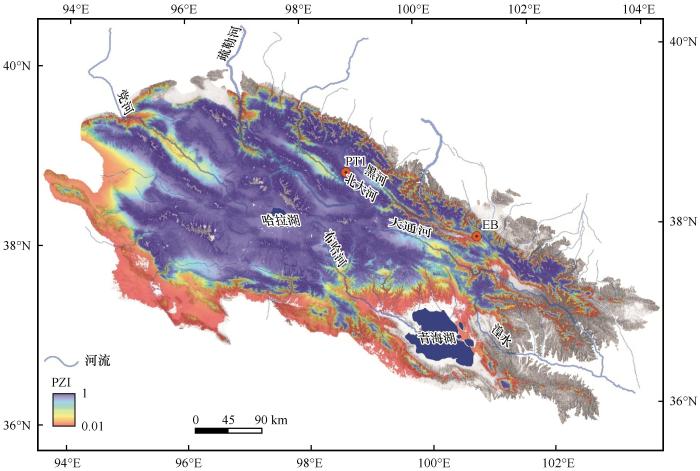
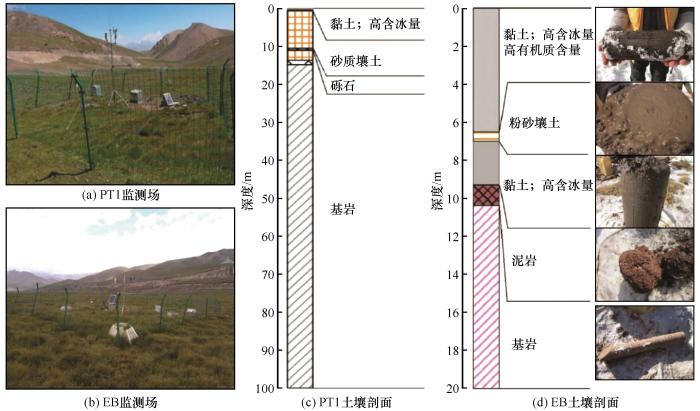
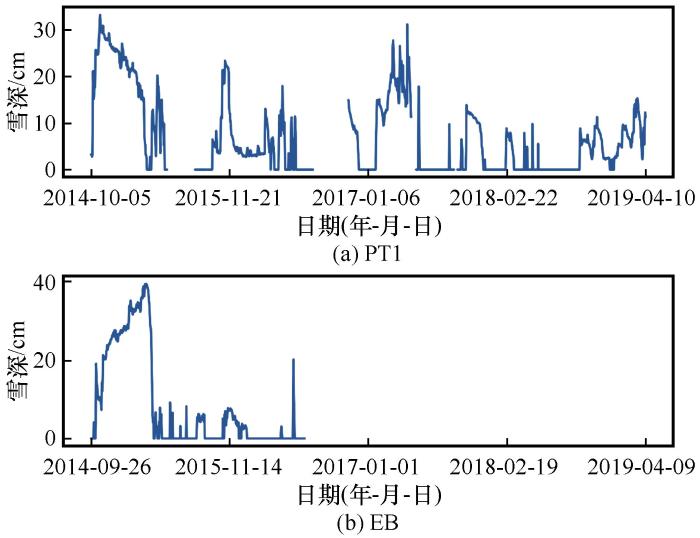
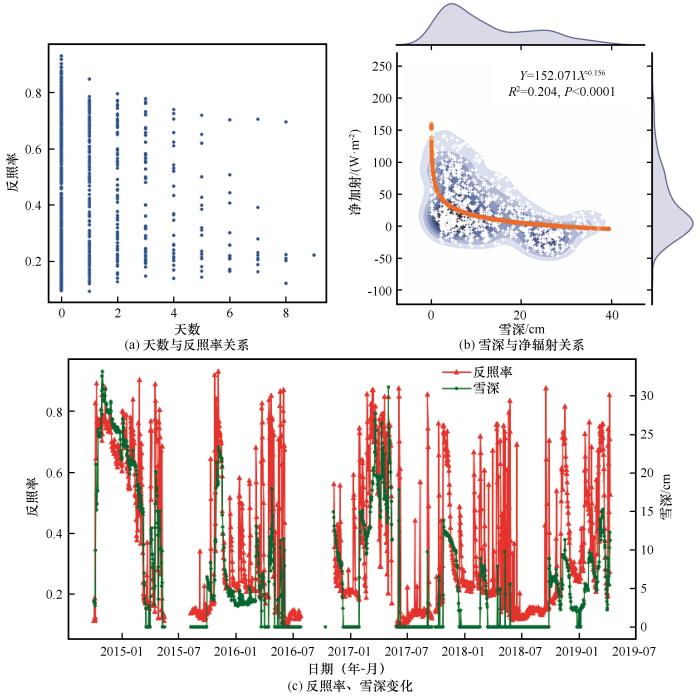
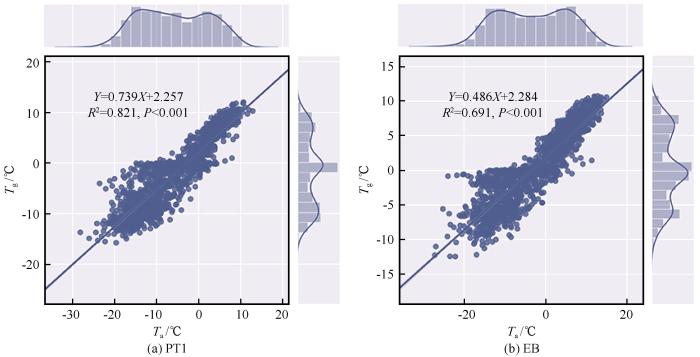
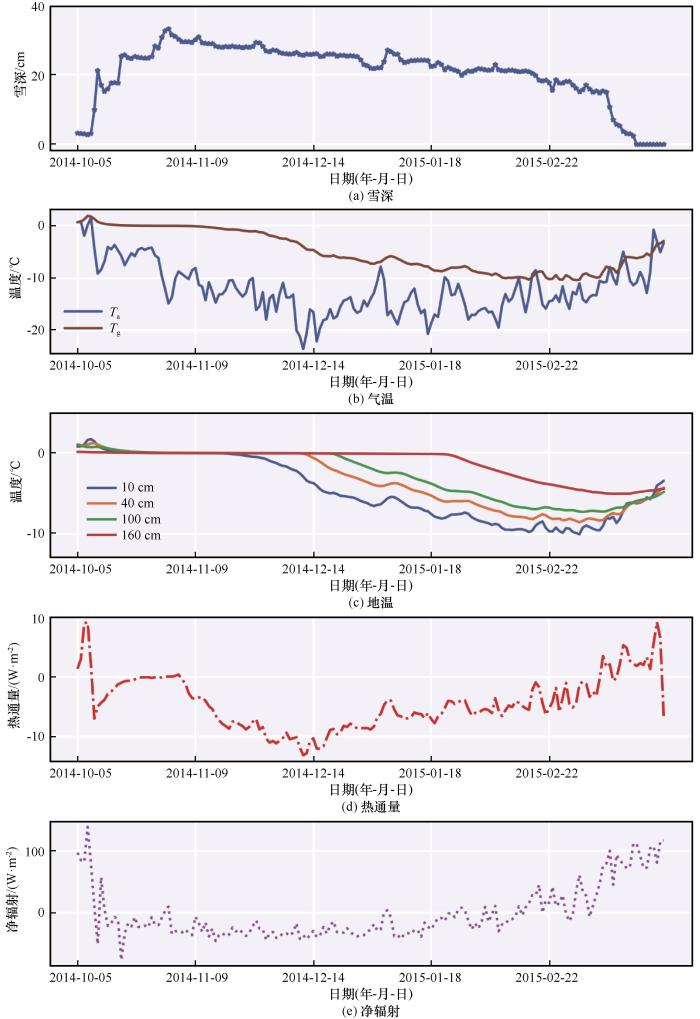
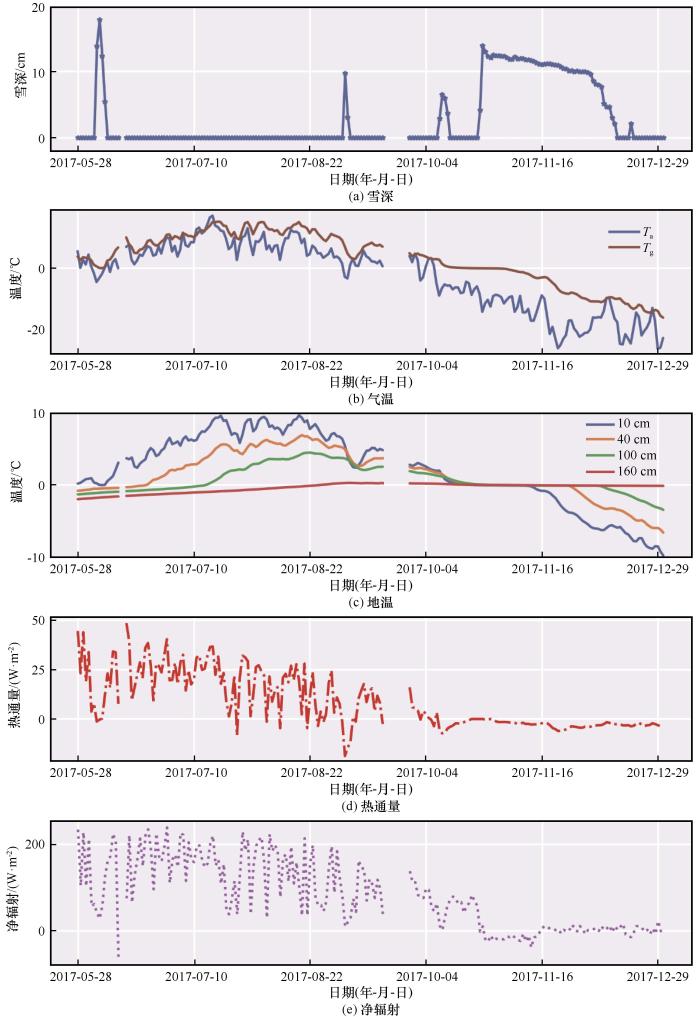
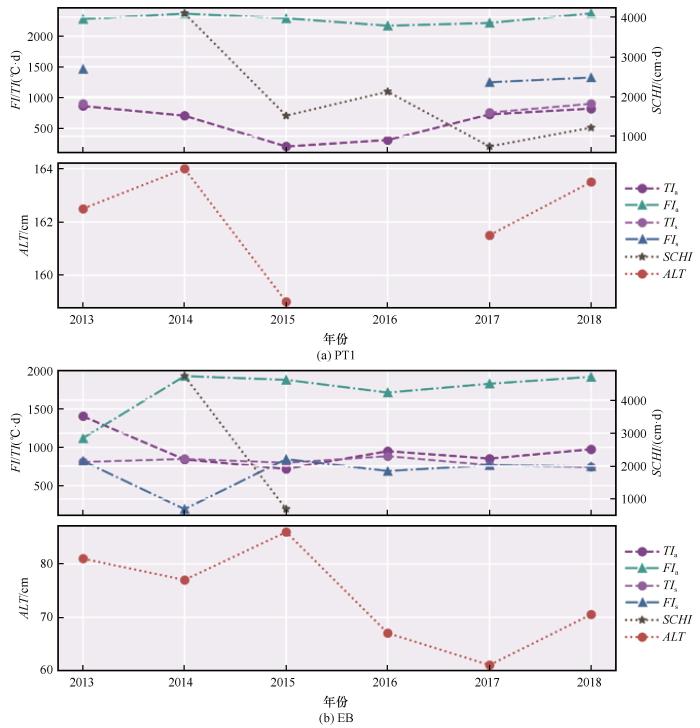
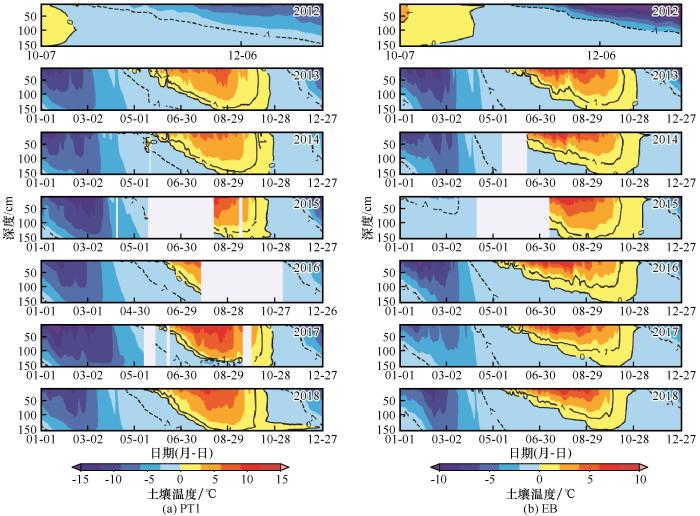

 甘公网安备 62010202000676号
甘公网安备 62010202000676号